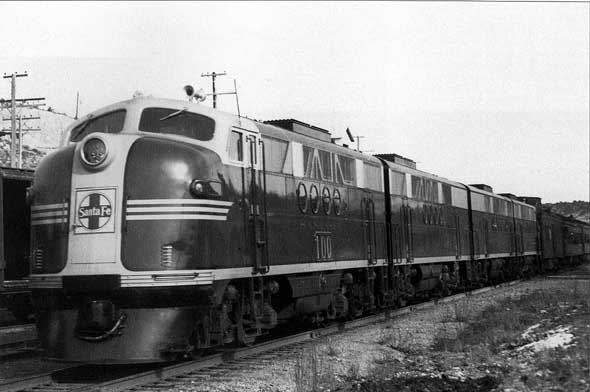 Brand new FT A-B-B-A set 100LA and 101LA pass through Nelson Arizona on what has to be one of their first trips after delivery in January 1941. Shortly 101LA would be renumbered to 100BC. Look closely inside the headlight housing for a multiple-bulb unit. Very shortly after delivery this was discarded in favor of a single bulb design. Note also the nose badge which contrasts with other photos made at the same date. The reason for the contrast is due simply to the angle of light reflection and has nothing to do with color differences in this example. |
|
In their early years the FT's were normally run as pure locomotive sets with the individual units operating together as one locomotive. By the mid- 1950s, individual units of different numbers began operating together and by the 1960's, it would have been relatively rare to find units with the same number in a lashup. Into the 1960's the last survivors of the FT fleet were concentrated in Clovis to Argentine service so they would be near their Cleburne shops maintenance point to run out their last miles, many being arranged in A-B-B-B-A sets. |
 FTA 405 (ex-143C) was one of a number of single unit FT road-swicher conversions with footboards front and rear and a steam locomotive type headlight at the rear on the roof. She carried full blue and yellow markings with the red stripe deleted completly but still with the "catwhisker" nose emblem at Bakersfield in May 1951. -Stan Kisler |
| HO scale FT models of varying quality have been available from time to time in brass over the past 30 years or so. The first brass FT model was probably the old Pacific Fast Mail/ Tenshodo FT imported from Japan in the late 1950's. The model was available factory painted in Santa Fe freight or passenger colors in A-B sets. It suffered from a very poorly contoured stamped nose and very crude detailing (by today's standards). Most of these have been relegated to collections these days and are seldom found in use on layouts. The next brass FT model was imported by Hallmark around 1970. These were made by KTM in Japan and featured a lost-wax casting nose that had very good contours. These came as a powered A/dummy B set and were available with side number boards per Santa Fe practice (or without per many other roads). These models ran well, but were very noisy as was the case with virtually all brass diesel models in those days. It was an era of brass spur gear drive trains with loose tolerances and big, noisy open frame motors. |







